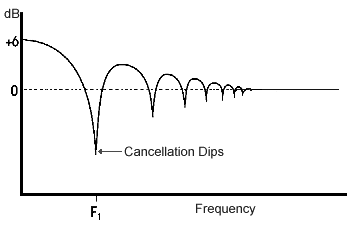Free Standing Studio Monitor Placement
Free Standing Studio Monitor Placement
Wall Reflections
If a speaker is placed near a wall, at low frequencies the wall will start to behave as an extension of the speaker baffle. Consequently, this will cause a boost in the bass level.
Reflections from the room boundaries simultaneously interfere with the direct sound from the speakers causing acoustic distortion.
Additionally, a free-standing speaker is almost always surrounded by surface boundaries that will generate reflections.
Because these boundaries act as acoustical mirrors to the direct sound, they enhance, or cancel, the direct sound. This depends on the phase difference between the reflection and the direct sound at the listening position.
Boundary reflection problems reduce as the frequency increases. This is because the speaker directivity increases with frequency. This is why the boundary reflections mainly cause problems at lower frequencies.
The most common problem at low frequencies is the interference between the direct sound and the reflection from the wall behind the speaker.
At low frequencies this reflection is in phase with the direct sound causing large peaks in the frequency response.
At a particular frequency the reflected sound will be delayed so much that it will be 180° out of phase with the direct sound.
Depending on the relative amplitudes of the direct and reflected sounds, a cancellation dip (6-20 dB deep) will occur in the frequency response.

The frequency response dips caused by a wall reflection
One way of overcoming this problem is to position the speakers further away from the walls. This will move the first order cancellation dip below the lower cut-off frequency of the speaker.
To move the cancellation dip to 50Hz, the distance needed would be around 1.7m.
In a stereo pair it is extremely important that they have matched frequency responses. We want to produce an exact, accurate, stereo image. The wall reflections will unbalance the L&R frequency responses if the speakers are at a different distance from the walls.
It is also extremely important that the speakers are positioned with exact symmetry in the listening room. Again to maintain similar frequency responses for both speakers.
This obviously implies that the listening room itself should be symmetrical along the axis between the speakers to fulfill this requirement.
Another method would be to place the speaker as close to the wall as possible to decrease the time delay of this reflection relative to the direct sound.
This moves the interference problem to a higher frequency. Consequently the speaker’s own directivity decreases the rearward radiation and, in this way, the amplitude of the reflected sound attenuates.
The resulting boost in the bass frequencies can be compensated for by using any room response controls that the speakers themselves may have.
Speaker Directivity
The loudspeaker naturally becomes more directive as the frequency increases, and the speaker has a certain acoustical axis where the response has been optimized.
The monitors should always be directed towards the listener. The frequency response at the listening position should be measured, and the room response controls can be adjusted to obtain correct balance if needed.
Stereo Placement
The height and width of the speakers’ stereo base is particularly important when mixing for film or TV.
Decisions on the width of the stereo base can significantly affect the sound mix especially if the mix position is too close to the speakers.
Room Modes
An enclosed loudspeaker behaves as a pressure source, and placed near the wall will excite ‘standing waves’ within the room. The only effective way to overcome this problem is to heavily damp the room with low frequency absorption material.
Summary
High quality near field monitoring requires an exactly symmetrical loudspeaker placement. Therefore, the speaker should be carefully directed towards the listener. The stereo base width and the height of the monitors should be set accordingly.
We also have an article about soffit mounting studio monitors.
